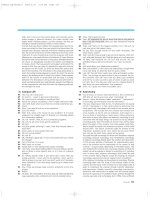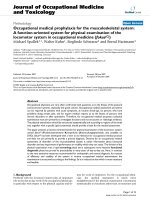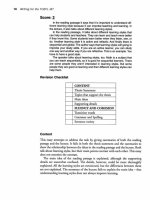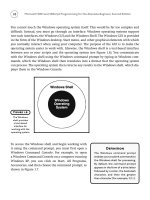Clinical Tests for the Musculoskeletal System - part 4 ppsx
Bạn đang xem bản rút gọn của tài liệu. Xem và tải ngay bản đầy đủ của tài liệu tại đây (868.53 KB, 31 trang )
Assessment:
A patient with a subscapularis tear will be unable to do
this.
Infraspinatus Test
Procedure:
This test may be performed with the patient seated or
standing.
Comparative testing of both sides is best. The patient’s arms should
hang relaxed with the elbows flexed 90° but not quite touching the
trunk. The examiner places his or her palms on the dorsum of each of
the patient’s hands and then asks the patient to externally rotate both
forearms against the resistance of the examiner’s hands.
Assessment:
Pain or weakness in e x t e rn a l rotation indicates a dis order
of the infraspinatus (external rotator). As infraspinatus tears are u sually
painless, weakness in rotation strongly suggests a tear in this muscle.
This test can also be performed with the arm abducted 90° and flexed
30° to eliminate involvement of the deltoid in this motion.
Teres Test
Procedure:
The patient is standing and relaxed. Th e examiner assesses
the position of the patient’s hands from behind.
Shoulder 73
Fig.
72
Lift-off test
Buckup, Clinical Tests for the Musculoskeletal System © 2004 Thieme
All rights reserved. Usage subject to terms and conditions of license.
Assessment:
The teres major is an internal rotator. Where a contrac-
ture is present, the palm of the affected hand will face backward
compared with the contralateral hand. With the patient standing in a
relaxed position, such a finding suggests a contracture of the teres
major.
74 Shoulder
a b
Fig.
73
Infraspinatus test
Fig.
74a, b
Teres test:
a
normal position,
b
contracture in the right arm
Buckup, Clinical Tests for the Musculoskeletal System © 2004 Thieme
All rights reserved. Usage subject to terms and conditions of license.
Weakness of the rotator cuff or a brachial plexus lesion can also
produce an asymmetrical h and position.
Nonspecific Supraspinatus Test
Procedure:
The patient is seated with the ar m abducted 90° with the
examiner’s hand resting on the patient’s forearm. The examiner then
asks the patient to further abduct the arm against the examiner’s
resistance.
Assessment:
Weakness in further abduction and/or pain indicate path-
ology of the supraspinatus tendon.
Drop Arm Test
Procedure:
The patient is seated, and the examiner passively abducts
the patient’s extended arm approximately 120°. The patient is asked to
hold the arm in this position without support and then slowly allow it to
drop.
Assessment:
Weakness in maintaining the position of the arm, with or
without pain, or sudden dropping of the arm suggests a rotator cuff
lesion. Most often this is d ue to a defect in the supraspinatus. In pseu-
doparalysis, the patient will be unable to lift the affected arm. Th is
global sign suggests a rotator cuff disorder.
Shoulder 75
Fig.
75
Nonspecific supraspinatus test Fig.
76
Drop arm test
Buckup, Clinical Tests for the Musculoskeletal System © 2004 Thieme
All rights reserved. Usage subject to terms and conditions of license.
Ludington Sign
Procedure:
The seated patient is asked to place both hands behind th e
neck.
Assessment:
If the patient has to make compensatory motions or is
able to place one hand behind the neck only with assistance, the limited
external rotation and abduction indicate the presence of a rotator cuff
tear.
Apley's Scratch Test
Procedure:
The seated patient is asked to touch the contralateral
superior medial corner of the scapula with t h e index finger.
Assessment:
Pain elicited in the rotator cuff and failure to reach the
scapula because of restricted mobility in external rotation and abduc-
tion indicate rotator cuff pathology (most probably involving the supra-
spinatus). A differential diagnosis should c onsider osteoarthritis in the
glenohumeral and acromioclavicular joints as well as capsular fibrosis.
76 Shoulder
Fig.
77
0° abduction test Fig.
78
Ludington sign Fig.
79
Apley's
scratch test
Buckup, Clinical Tests for the Musculoskeletal System © 2004 Thieme
All rights reserved. Usage subject to terms and conditions of license.
Painful Arc
Procedure:
The arm is passively and actively abducted from the rest
position alongside the trunk.
Assessment:
Pain occurring in abduction between 70° and 120° (Fig.
80b
) is a sign of a lesion of the supraspinatus tendon, which becomes
impinged between the greater tubercle of the humerus and the acro-
mion in this phase of the motion (subacromial impingement). (Contrast
this with the painful arc in acromioclavicular joint disorders, where the
pain only occurs only at 140°–180° of abduction, Fig.
80c
; see also Fig.
84
). Patients are usually free of pain above 120°.
In the evaluation of the active and passive ranges of motion, the
patient can often avoid the painful arc by externally rotating the arm
while abducting it. This increases the clearance between the acromion
and the diseased tendinous portion of the rotator cuff, avoiding im-
pingement in the range between 70° and 120°.
Shoulder 77
a b c
Fig.
80a–c
Painful arc:
a
starting position,
b
painful motion between 30° and 120°,
c
pain at the end of the range of motion, a sign of acromioclavicular joint
pathology.
Buckup, Clinical Tests for the Musculoskeletal System © 2004 Thieme
All rights reserved. Usage subject to terms and conditions of license.
In addition to complete or incomplete rotator cuff tears, swelling and
inflammation as a result of bursitis and abnormality of the margin of the
acromion occasionally lead to impingement with a painful arc, as does
osteoarthritis in the acromioclavicular joint.
Neer Impingement Sign
Procedure:
The examiner immobilizes the scapula with one hand
while the other hand jerks the patient’s arm forward, upward, and
sideways (medially) into the scapular p lane.
Assessment:
If an impingement syndrome is present, subacromial
constriction or impingement of the diseased area against the anterior
inferior margin of the acromion will produce severe pain with motion.
78 Shoulder
a b
Fig.
81a, b
Neer impingement sign:
a
starting position,
b
forcible forward flexion and adduction of the extended arm
Buckup, Clinical Tests for the Musculoskeletal System © 2004 Thieme
All rights reserved. Usage subject to terms and conditions of license.
Hawkins Impingement Sign
Procedure:
The examiner immobilizes the scapula with one hand
while the other hand adducts the patient’s 90°-forward-flexed and
internally rotated arm (moving it toward the contralateral side of the
body).
Assessment:
If an im pingement syndro me is present, the supr aspina-
tus tendon will become pinched beneath or against the coracoacromial
ligament, causing severe pain on motion. Coracoid impingem ent is
revealed by the adduction motion, in which the supraspinatus tendon
also impinges against the coracoid process.
In the Jobe impingement test, the forward flexed and slightly ad-
ducted arm is forcibly internally rotated. This will provoke typical
impingement pain.
Shoulder 79
a b
Fig.
82
Hawkins impingement sign:
a
starting position
b
forcible internal rotation (Jobe)
Buckup, Clinical Tests for the Musculoskeletal System © 2004 Thieme
All rights reserved. Usage subject to terms and conditions of license.
Neer Impingement Injection Test
Procedure:
The subacromial space is infiltrated with an ane sthetic.
Assessment:
This test allows the examiner to determine whether sub-
acromial impingement is the cause of the painful arc. A painful arc that
disappears or improves after the injection is caused by changes in the
subacromial space, such as bursitis or an activated rotator cuff defect.
˾
Acromioclavicular Joint
The acromial end of the clavicle articulates with the acromion. The
acromioclavicular ligament reinforces the capsule of this joint. Func-
tionally, the articulation is a ball-and-socket joint whose range of mo-
tion is less than that of the sternoclavicular joint. Another strong liga-
ment joins the scapula and clavicle, the coracoclavicular ligament. It
arises from the coracoid process and inserts into the inferior aspect of
the clavicle. Arthritic changes in the acromioclavicular joint cause pain
and further constrict the subacromial space. In addition to pain with
motion and tenderness to palpation over the acromioclavicular joint,
findings will often include palpable bony thickening of the articular
80 Shoulder
Fig.
83
Neer impingement injection test
Buckup, Clinical Tests for the Musculoskeletal System © 2004 Thieme
All rights reserved. Usage subject to terms and conditions of license.
margin. Tossy classifies acromioclavicular joint injuries into three de-
grees of severity:
Tossy type 1: Contusion of the acromioclavicular joint without signif-
icant injury to the capsule and ligaments.
Tossy type 2: Subluxation of the acromioclavicular joint with rupture
of the acromioclavicular ligaments.
Tossy type 3: Dislocation of the acromioclavicular joint with additional
rupture of the coracoclavicular ligaments.
In severe injuries to the capsule and ligaments, the pull of the cervical
musculature causes the lateral end of the clavicle to displace proximally.
From there it can be reduced inferiorly against elastic resistance. This
procedure is sometimes referred to as the “piano key” phenomenon.
Painful Arc
Procedure:
The patient’s arm is passively and actively abducted from
the rest position alo ngside the trunk.
Assessment:
Pain in the acromioclavicular joint occurs between 140°
and 180° of abduction. Increasing abduction leads to increasing com-
Shoulder 81
a b
c
Fig.
84a–c
Painful arc:
a
starting position,
b
pain between 30° and 120°(sign of a supraspinatus syndrome),
c
pain between 140° and 180° (sign of osteoarthritis in the acromioclavicular
joint)
Buckup, Clinical Tests for the Musculoskeletal System © 2004 Thieme
All rights reserved. Usage subject to terms and conditions of license.
pression and contortion in the joint. (In an impingement syndrome or a
rotator cuff tear, by comparison, pain symptoms will occur between 70°
and 120°; see Fig.
80
).
Forced Adduction Test
Procedure:
The 90°-abducted arm on the affected side is forcibly
adducted across the chest toward the normal side.
Assessment:
Pain in the acromioclavicular joint suggests joint pathol-
ogy or anterior impingement. (Absence of pain after injection of an
anesthetic is a sign of joint disease.)
Forced Adduction Test on Hanging Arm
Procedure:
The examine r grasps the upper arm of the affected side
with one hand while th e other hand rests on the contralateral sh oulder
and immobilizes the shoulder girdle. Then the examiner forcibly a d-
ducts the hanging affected arm behind the patient’s back against the
patient’s resistance.
82 Shoulder
Fig.
85
Forced adduction test Fig.
86
Forced adduction test on
hanging arm
Buckup, Clinical Tests for the Musculoskeletal System © 2004 Thieme
All rights reserved. Usage subject to terms and conditions of license.
Assessment:
Pain across the anterior aspect of the shoulder suggests
acromioclavicular joint disease or subacromial impingement. (Symp-
toms that disappear or improve following injection of an anesthetic
indicate that the acromioclavicular joint is causing the pain.)
Test of Horizontal Mobility of the Lateral Clavicle
Procedure:
The examiner grasps the lateral end of the clavicle be-
tween two fingers and moves it in every direction.
Assessment:
Increased mobility of the lateral clavicle with or without
pain is a sign of instability in the acromioclavicular joint. In isolated
osteoarthritis there will be circumscribed tenderness to palpation and
pain with motion. Acromioclavicular joint separation with rupture of
the coracoclavicular ligaments will be accompanied by a positive “piano
key” sign: the subluxated lateral end of the clavicle displaces proximally
with the pull of the cervical musculature and can be pressed inferiorly
against elastic resistance.
Dugas Test
Procedure:
The patient is seated or standing and touches the contrala-
teral shoulder with the hand of the 90°-flexed arm of the affected side.
Shoulder 83
Fig.
87
Test of horizontal mobility of
the lateral clavicle
Fig.
88
Dugas test
Buckup, Clinical Tests for the Musculoskeletal System © 2004 Thieme
All rights reserved. Usage subject to terms and conditions of license.
Assessment:
Acromioclavicular joint pain suggests joint disease (os-
teoarthritis, instability, disk injury, or infection). A differential diagnosis
must exclude anterior subacromial impingement, due to the topo-
graphic proximity of that region.
˾
Long Head of the Biceps Tendon
A rupture of the long head of the biceps tendon will appear as a distally
displaced protrusion of the muscle belly of the biceps. The close ana-
tomic proximity of the intraarticular portion of the tendon to the
coracoacromial arch predisposes it to involvement in degenerative
processes in the subacromial space. A rotator cuff tear is often accom-
panied by a rupture of the long head of the biceps tendon.
Isolated inflammation of the long head of the biceps tendon (bicipital
tenosynovitis) is accordingly rare. In younger patients, this may occur as
a tennis or throwing injury. Subluxations of the long head of the biceps
tendon in the bicipital groove are usually dif• cult to detect. However, a
series of specific tests can be used to diagnose biceps tendon injuries;
the typical sign of these injuries is not the distally displaced muscle belly
but incomplete contraction and/or “snapping” of the tendon.
Nonspecific Biceps Tendon Test
Procedure:
The patient holds the arm abducted in neutral rotation
with the elbow flexed 90°. The examiner immobilizes the patient’s
elbow with one hand and places the heel of the other hand on the
patient’s distal forearm. The patient is then asked to externally rotate his
or her arm against the resistance of the examiner’s hand.
Assessment:
Pain in the bicipital groove or at the insertion of the
biceps suggests a tendon disorder.
Pain in the anterolateral aspe ct of the shoulder is often a sign of a
disorder of the rotator cuff, especially the infraspinatus tendon.
Abbott-Saunders Test
Demonstrates subluxation of the long head of the biceps tendon in the
bicipital groove.
Procedure:
The patient’s arm is externally rotated and abducted about
20°. The examiner slowly lowers the arm from this position. The exam-
iner guides this motion of the patient’s arm with one hand whi le resting
84 Shoulder
Buckup, Clinical Tests for the Musculoskeletal System © 2004 Thieme
All rights reserved. Usage subject to terms and conditions of license.
Assessment:
Acromioclavicular joint pain suggests joint disease (os-
teoarthritis, instability, disk injury, or infection). A differential diagnosis
must exclude anterior subacromial impingement, due to the topo-
graphic proximity of that region.
˾
Long Head of the Biceps Tendon
A rupture of the long head of the biceps tendon will appear as a distally
displaced protrusion of the muscle belly of the biceps. The close ana-
tomic proximity of the intraarticular portion of the tendon to the
coracoacromial arch predisposes it to involvement in degenerative
processes in the subacromial space. A rotator cuff tear is often accom-
panied by a rupture of the long head of the biceps tendon.
Isolated inflammation of the long head of the biceps tendon (bicipital
tenosynovitis) is accordingly rare. In younger patients, this may occur as
a tennis or throwing injury. Subluxations of the long head of the biceps
tendon in the bicipital groove are usually dif• cult to detect. However, a
series of specific tests can be used to diagnose biceps tendon injuries;
the typical sign of these injuries is not the distally displaced muscle belly
but incomplete contraction and/or “snapping” of the tendon.
Nonspecific Biceps Tendon Test
Procedure:
The patient holds the arm abducted in neutral rotation
with the elbow flexed 90°. The examiner immobilizes the patient’s
elbow with one hand and places the heel of the other hand on the
patient’s distal forearm. The patient is then asked to externally rotate his
or her arm against the resistance of the examiner’s hand.
Assessment:
Pain in the bicipital groove or at the insertion of the
biceps suggests a tendon disorder.
Pain in the anterolateral aspe ct of the shoulder is often a sign of a
disorder of the rotator cuff, especially the infraspinatus tendon.
Abbott-Saunders Test
Demonstrates subluxation of the long head of the biceps tendon in the
bicipital groove.
Procedure:
The patient’s arm is externally rotated and abducted about
20°. The examiner slowly lowers the arm from this position. The exam-
iner guides this motion of the patient’s arm with one hand whi le resting
84 Shoulder
Buckup, Clinical Tests for the Musculoskeletal System © 2004 Thieme
All rights reserved. Usage subject to terms and conditions of license.
the other on the patient’s shoulder and palpating the bicipital groove
with the index and middle fingers.
Assessment:
Pain in the region of the bicipital groove or a palpable or
audible snap suggest a disorder of the biceps tendon (subluxation sign).
An inflamed bursa (subcoracoid or subscapular bursa) can also occa-
sionally cause snap ping.
Speed Test
Procedure:
The patient’s arm is extended in supination at 90° of
abduction and 30° of horizontal flexion. The patient attempts to either
maintain this position or continue to abduct the arm against the down-
ward pressure of the examiner’s hand.
Assessment:
Asymmetrical abduction strength with pain in the region
of the bicipital groove suggests a disorder of the long head of the biceps
tendon (tenosynovitis or a subluxation phenomenon).
Shoulder 85
Fig.
89
Nonspecific biceps
tendon test
Fig.
90
Abbott-Saunders test
Buckup, Clinical Tests for the Musculoskeletal System © 2004 Thieme
All rights reserved. Usage subject to terms and conditions of license.
Snap Test
Tests for subluxation of the long head of the biceps tendon.
Procedure:
The examiner palpates the bicipital groove with the index
and middle finger of one hand. With the other hand, the examiner
grasps the wrist of the patient’s arm (abducted 80°–90° and flexed
90° at the elbow) and passively rotates it at the shoulder, first in one
direction and then the other.
Assessment:
Subluxation of the long head of the biceps tendon out of
the bicipital groove will be detectable as a palpable snap.
Yergason Test
Functional test of the long head of the biceps tendon.
Procedure:
The patient’s arm is alongside the trunk and flexed 90° at
the elbow. One of the examiner’s hands rests on the patient’s shoulder
and palpates the bicipital groove with the index finger while the other
hand grasps the patient’s forearm . The patient is asked to supinate the
forearm against the examiner’s resistance. This places isolated tension
on the long head of the biceps tendon.
Assessment:
Pain in the bicipital groove is a sign of a lesion of the
biceps tendon, its tendon sheath , or its ligamentous connection via the
transverse ligament. The typical provoked pain can be increased by
pressing on the tendon in the bicipital groove.
86 Shoulder
Fig.
91
Speed test
Buckup, Clinical Tests for the Musculoskeletal System © 2004 Thieme
All rights reserved. Usage subject to terms and conditions of license.
Hueter Sign
Procedure:
The patient is seated with the arm extended at the elbow
and the forearm in supination. The examiner grasps the posterior aspect
of the patient’s forearm. The patient is then asked to flex the elbow
against the resistance of the examiner’s hand .
Shoulder 87
a b
Fig.
92a, b
Snap test:
a
external rotation,
b
internal rotation
Fig.
93
Yergason test
Fig.
94
Hueter sign
Buckup, Clinical Tests for the Musculoskeletal System © 2004 Thieme
All rights reserved. Usage subject to terms and conditions of license.
Assessment:
In a rupture of the long head of the biceps tendon, the
distally displaced muscle belly can be observed as a “ball” directly
proximal to the elbow.
Transverse Humeral Ligament Test
Procedure:
The patient is seated w ith the arm abducted 90°, internally
rotated, and ext ended at the elbow. From this position, the examiner
externally rotates the arm while palpating the bicipital groove to verify
whether the tendon snaps.
Assessment:
In the presence of ligamentous insuf• ciency, this motion
will cause the biceps tendon to spontaneously displace out of the
bicipital groove. Pain reported without displacement suggests biceps
tendinitis.
Thompson and Kopell Horizontal Flexion Test
(Cross-Body Action)
Procedure:
The patient is standing and moves the 90-° abducted arm
across the body into maximum horizontal flexion.
Assessment:
Dull, deep-seated pain above the superior margin of the
scapula in the supraspinatus fossa and on the posterolateral scapula
radiating into the upper arm can be caused by compression of the
suprascapular nerve beneath the transverse scapular ligament as a
result of di stal displacement of the scapula.
88 Shoulder
a b
Fig.
95a, b
Transverse humeral ligament test:
a
starting position,
b
palpating the biceps tendon in internal rotation
Buckup, Clinical Tests for the Musculoskeletal System © 2004 Thieme
All rights reserved. Usage subject to terms and conditions of license.
Note:
A differential diagnosis must consider pain due to acromiocla-
vicular joint pathology. Such pain can also be elicited by this test
maneuver.
Ludington Test
Procedure and assessment:
Both arms are abducted and the palms
placed on the head with the fingers interlaced. In a positive test, volun-
tary contraction of the biceps causes pain in the anterior deltoid region.
Lippman Test
Procedure and assessment:
With the patient’s arm flexed 90° at the
elbow, the examiner palpates the bicipital groove about 3 cm distal to
the glenohumeral joint. Where the biceps tendon has a tendency to
subluxate or dislocate, the examiner can provoke sub luxation or dis-
location by palpation. This will usually be accompanied by pain.
DeAnquin Test
Procedure and assessment:
Rotating the upper arm while palpating
the biceps tendon in the bicipital groove causes pain in the presence of
biceps tendon pathology.
Gilcrest Test
Procedure and assessment:
Reducing the biceps tendon into the
bicipital groove during slow adduction after subluxation or displace-
ment in elevation leads to increased pain in the anterior deltoid region.
Shoulder 89
Fig.
96
Thompson and Kopell horizontal flexion test
Buckup, Clinical Tests for the Musculoskeletal System © 2004 Thieme
All rights reserved. Usage subject to terms and conditions of license.
Beru Sign
Procedure and assessment:
Displacement of the long head of the
biceps tendon can be palpated beneath the anterior deltoid whe n the
biceps is vo luntarily contracted.
Duga Sign
Procedure and assessment:
Where a lesion of the long head of the
biceps tendon is present, the patient will be unable to to uch the con-
tralateral shoulder with the affected arm.
Traction Test
Procedure and assessment:
Passive retroflexion of the shoulder with
the elbow extended and the forearm in pronation causes pain in the
anterior deltoid region along the course of the biceps tendon. This pain
also occurs if the patient attempts to actively supinate the forearm from
this position, flex the elbow, or forward flex the shoulder.
Compression Test
Procedure and assessment:
Passive elevation of the arm to the end of
its range of motion with continued application of posterior pressure
90 Shoulder
Fig.
97
Traction test Fig.
98
Compression test
Buckup, Clinical Tests for the Musculoskeletal System © 2004 Thieme
All rights reserved. Usage subject to terms and conditions of license.
produces pain as a result of compression of the biceps tendon between
the acromion and humeral head.
Evaluation of the range of motion is crucial in patients with sus-
pected shoulder instability. Rotation should be examined both in ad-
duction and 90°-abduction. Restricted external rotation in both adduc-
tion and abduction will often be the first sign of instability in patients
with anterior instability. Flexion and abduction in the scapular plane are
not normally restricted.
˾
Shoulder Instability
Chronic shoulder pain m ay be attributable to an unstable shoulder. The
clinical picture of sub luxation in particular is often dif• cult to diagnose,
and patients themselves can usually give only a vague description of
their symptoms.
According to Neer, instability pa tients invariably have a history of a
period of intensive shoulder use (such as competitive sports), an epi-
sode of repeated minor trauma (overhead use), or generalized ligament
laxity. Both young athletes and inactive persons are affected, men and
women alike.
The transition between subluxation and dislocation is continuous.
Patients with voluntary instability are a separate issue. In such cases,
consultation with a psychologist may be helpful in addition to repeated
clinical examination.
The differential diagnosis must specifically consider an impingement
syndrome, a rotator cuff tear, osteoarthritis in the acromioclavicular
joint, and also a cervical spine syndrome. In cases of doubt, injection
of a local anesthetic at the point of maximum pain m ay be requ ired.
However, this treatment cannot permanently eliminate instability
symptoms. Signs of generalized ligament laxity may include increased
mobility in other joints and, especially, increased hyperextension in the
elbow or r etroflexion in the metacarpophalangeal joint of the thumb
with the forearm extended. The use of a variety of relatively specific
tests will make it easier for the examiner to arrive at a diagnosis.
Assessment of the range of motion is crucial in patients with sus-
pected shoulder instability. Rotation should be examined in both ad-
duction and 90-° abduction. Restricted external rotation in both adduc-
tion and abduction will often be the first sign of instability in patients
with anterior instability. Flexion and abduction in the scapular plane are
not normally restricted.
Shoulder 91
Buckup, Clinical Tests for the Musculoskeletal System © 2004 Thieme
All rights reserved. Usage subject to terms and conditions of license.
produces pain as a result of compression of the biceps tendon between
the acromion and humeral head.
Evaluation of the range of motion is crucial in patients with sus-
pected shoulder instability. Rotation should be examined both in ad-
duction and 90°-abduction. Restricted external rotation in both adduc-
tion and abduction will often be the first sign of instability in patients
with anterior instability. Flexion and abduction in the scapular plane are
not normally restricted.
˾
Shoulder Instability
Chronic shoulder pain m ay be attributable to an unstable shoulder. The
clinical picture of sub luxation in particular is often dif• cult to diagnose,
and patients themselves can usually give only a vague description of
their symptoms.
According to Neer, instability pa tients invariably have a history of a
period of intensive shoulder use (such as competitive sports), an epi-
sode of repeated minor trauma (overhead use), or generalized ligament
laxity. Both young athletes and inactive persons are affected, men and
women alike.
The transition between subluxation and dislocation is continuous.
Patients with voluntary instability are a separate issue. In such cases,
consultation with a psychologist may be helpful in addition to repeated
clinical examination.
The differential diagnosis must specifically consider an impingement
syndrome, a rotator cuff tear, osteoarthritis in the acromioclavicular
joint, and also a cervical spine syndrome. In cases of doubt, injection
of a local anesthetic at the point of maximum pain m ay be requ ired.
However, this treatment cannot permanently eliminate instability
symptoms. Signs of generalized ligament laxity may include increased
mobility in other joints and, especially, increased hyperextension in the
elbow or r etroflexion in the metacarpophalangeal joint of the thumb
with the forearm extended. The use of a variety of relatively specific
tests will make it easier for the examiner to arrive at a diagnosis.
Assessment of the range of motion is crucial in patients with sus-
pected shoulder instability. Rotation should be examined in both ad-
duction and 90-° abduction. Restricted external rotation in both adduc-
tion and abduction will often be the first sign of instability in patients
with anterior instability. Flexion and abduction in the scapular plane are
not normally restricted.
Shoulder 91
Buckup, Clinical Tests for the Musculoskeletal System © 2004 Thieme
All rights reserved. Usage subject to terms and conditions of license.
Anterior Apprehension Test
Tests of shoulder stability.
Procedure:
The examination begins with the patient seated. T he ex-
aminer grasps the humeral head through the surrounding soft tissue
with one hand and guides the patient’s arm with the other hand. The
examiner passively abducts the patient’s shoulder with the elbow flexed
and then brings the shoulder into maximum external rotation, keeping
the arm in this position. The test is performed at 60°, 90°, and 120° of
abduction to evaluate the superior, medial, and inferior glenohumeral
ligaments. With the guiding hand, the examiner presses the humeral
head in an anterior and inferior direction.
This test may be performed with the patient supine to better relax the
shoulder musculature. The shoulder lies on the edge of the examining
table, which acts as a fulcrum. In this position, the apprehension sign can
be elicited in various positions of external rotation and abduction (ful-
crum test). The normal contralateral shoulder is used as reference.
Assessment:
Shoulder pain with reflexive muscle tensing is a sign of an
anterior instability syndrome. This muscle tension is an attempt by the
patient to prevent imminent subluxation or dislocation of the humeral
head.
Even without pain, isolated muscle tensing in the an terior shoulder
region (pectoralis) can be a sign of an instability syndrome.
With the patient supine, the apprehension test can often be made
more specific (Fowler test; Fig.
99c, d
). In the apprehension position, the
humeral head is pressed poste riorly. This rapidly reduces the patient’s
pain and fear of dislocation.
In another stage of the apprehension test, relieving the p osteriorly
directed pressure on the humeral head causes a sudden increase in pain
with the apprehension phenomenon.
In Jobe’s modification, the apprehension phenomenon can also be
classified in degrees of severity. Increasing posterior pressure on the
humeral head produces increasing pain and sensation of dislocation
corresponding to the increasing external rotation and ab duction.
Note:
When the patient complains of sudden stabbing pain with simul-
taneous or subsequent paralyzing weakness in the affected extremity,
this is referred to as the “dead arm sign.” It is attributable to the transient
compression the subluxated humeral head exerts on the plexus.
It is important to know that at 45° of abduction, the test primarily
evaluates the medial gle no humeral ligament and the subscapularis
tendon. At or above 90° of abduction, the stabilizing effect of the sub-
92 Shoulder
Buckup, Clinical Tests for the Musculoskeletal System © 2004 Thieme
All rights reserved. Usage subject to terms and conditions of license.
scapularis is neutralized and the test primarily e valuates the inferior
glenohumeral ligament.
Apprehension Test (Supine)
Procedure:
The patient is supine with the arm abducted, externally
rotated, and flexed at the elbow. The examiner exerts posterior pressure
to displace the humeral head anteriorly.
Stability should be tested at 60°, 90°, and 120° of abduction.
Shoulder 93
a b
c d
Fig.
99a–d
Anterior apprehension test:
a
starting position,
b
test position,
c
supine with posteriorly directed pressure applied to the humeral head,
d
after relieving the posteriorly directed pressure
Buckup, Clinical Tests for the Musculoskeletal System © 2004 Thieme
All rights reserved. Usage subject to terms and conditions of license.
Assessment:
The patient with anterior instability expects pain the
farther the humeral head moves anteriorly past the labrum in the
direction of potential dislocation. The patient reacts with an avoidance
movement.
Rowe Test
Procedure:
The patient stands and bends forward slightly with the
arm relaxed. To examine the right shoulder, the examiner grasps the
patient’s shoulder with the left hand and with the right h and passively
moves the patient’s arm slightly anteriorly and inferiorly.
Assessment:
This position allows the examiner to perform a slight
anterior-inferior translation and evaluate the stability of the shoulder.
Throwing Test
Procedure and assessment:
In the throwing test, the patient executes
a rapid throwing motion against the examiner’s resistance. This test can
reveal anterior subluxation that occurs during the throwing motion.
Leffert Test
Procedure and assessment:
The Leffert test can be used to quantify a
drawer phe nomenon. Looking downward at the shoulder of the seated
94 Shoulder
Fig.
100
Apprehension test (supine) Fig.
101
Rowe test
Buckup, Clinical Tests for the Musculoskeletal System © 2004 Thieme
All rights reserved. Usage subject to terms and conditions of license.
patient (craniocaudal view), the examiner displaces the humeral head
anteriorly. The anterior displacement of the examiner’s index finger in
relation to the middle finger shows the degree of anterior translation of
the h umeral head.
Anterior and Posterior Drawer Test
Procedure:
The patient is seated. The examiner stands behind the
patient. To evaluate the right shoulder, the examiner grasps the pa-
tient’s shoulder with the left han d to stabilize the clavicle and superior
margin of the scapula while using the right hand to move the humeral
head anteriorly and posteriorly.
Assessment:
Significant anterior or posterior mobility of the humeral
head suggests instability.
Shoulder 95
a b
Fig.
102
Throwing test
Fig.
103a, b
Leffert test:
a
starting position,
b
index finger displaced
anteriorly
Buckup, Clinical Tests for the Musculoskeletal System © 2004 Thieme
All rights reserved. Usage subject to terms and conditions of license.









